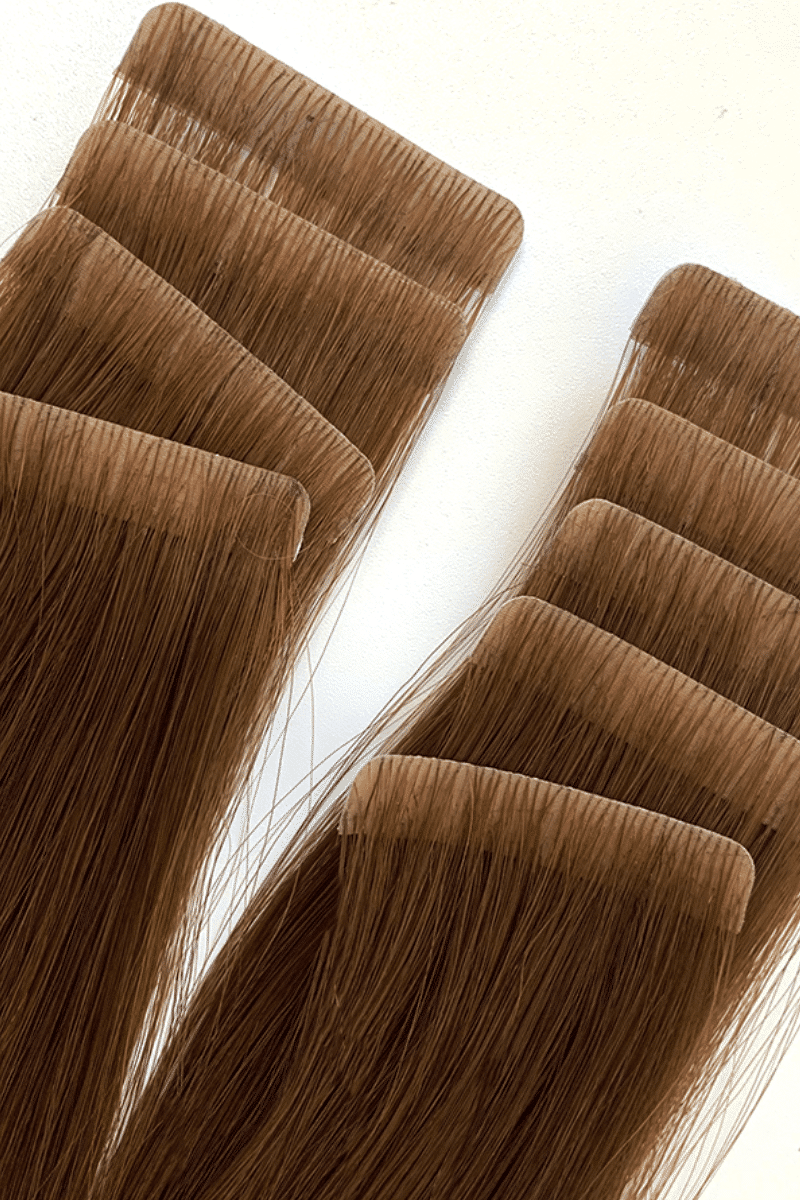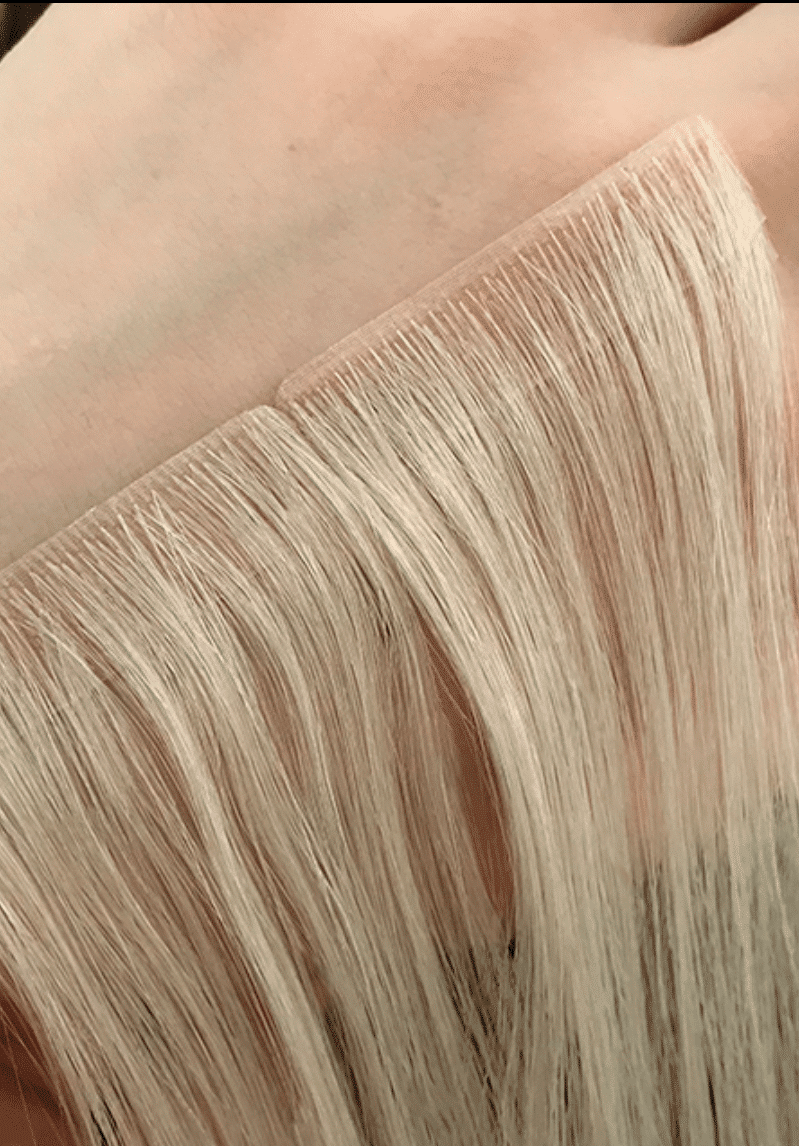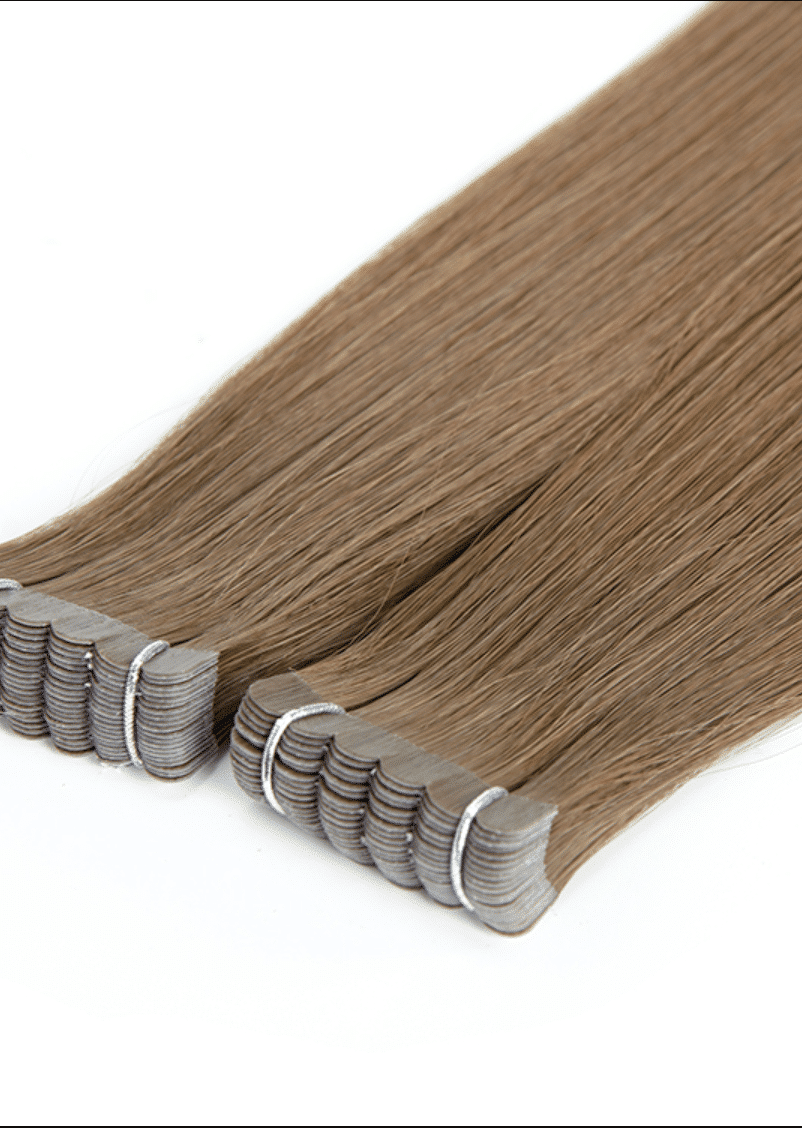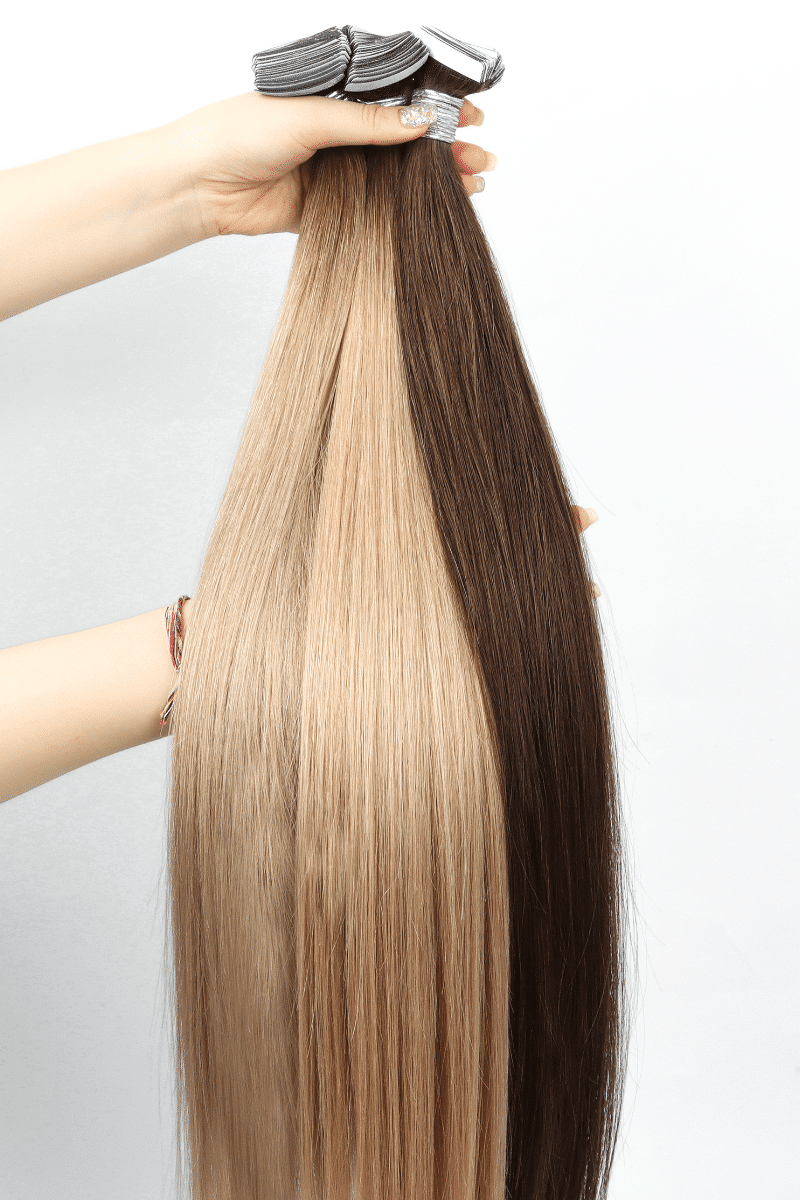Why Tape In Extensions Are The Best Hair Extension Method?

Have you heard why tape in extensions is the best hair extensions on the market?
When you first try tape in hair extensions you will be wondering why you didn’t try it sooner. Extensions not only have the possibility to add length to your hair but also volume. It is a way to keep your natural hair healthy and give you a sense of confidence that you’ve been dreaming of in a quick and easy way.
With an oversaturated hair extension market, it’s hard to keep track of the different methods. Which is the best method? Below are reasons why we think tape in extensions is the best method on the market:
PRICE
The least expensive and semi-permanent hair extension method is tape in extensions. For the price of hair and application, this method definitely pays for itself. The reason for this is tape in extensions are quick and easy to apply compared to other methods. Also, to maintain and care for tape in extensions the cost is way lower than other semi-permanent methods.
MAINTENANCE
The maintenance of tape in extensions is the easiest and lowest to maintain out of all semi-permanent extension methods. The size of each panel makes it easy to care for like it’s your own hair. Once you have the tape in extensions placed in your hair, you can forget about them and treat them as you would your own hair until it’s time to get retapped. The average time between retapes is 6-8 weeks depending on how fast your hair will grow. If you take care of your extensions, you can reuse them for over a year! We recommend using our Heat Treat + Shine to protect against damage.
LESS DAMAGE
Out of all of the semi-permanent hair extension methods on the market, tape in extensions is the least damaging to your natural hair. Our panels are lightweight and do not tug on hair like other methods and brands do. The panels will grow out with your hair and keep it protected. Tape in hair extensions is non-damaging and easy to remove. Other methods, such as fusion or sew in, are known to tug at the hair and cause hair loss and damage. Because of the easy removal process, tape ins are the only method that protects hair and grows with it.
VERSATILE
When you wear tape in hair extensions, the possibilities are endless. There are many different hairstyles that you can do with tape in extensions, such as a high ponytail. They are flexible and move with your natural hair for a flawless finish. If you take care of your extensions, they will not tangle and will be easy to work with. If you want a seamless and effortless look, tape in hair extensions is the only way to go.
Everything You’ve Ever Wanted to Know About Getting Tape-In Extensions.
Switching up your hair to a longer, fuller, more voluminous style is fun, and one of the best (most non-committal) ways to achieve a major hair makeover is by experimenting with extensions. Your hairstyle options are practically endless when it comes to extensions—they give you even more freedom to rock unexpected cuts and colors. Trust us, once you look in the mirror, you’ll feel like a whole new person. This is coming from a reformed extensions addict—I hid my natural hair underneath extensions for two years straight at one point in time.

Suffice it to say, it’s easy to get lost in the land of extensions because they make you look (and feel) flawless.
There are a few different types of extensions you can get. One option is sewn-in extensions that are applied with a needle and can last up to three months. If you’re going for a one-night type of hair vibe, clip-in extensions are an easy, non-adhesive option that allows you to clip them in and out of your natural hair. But let’s talk about the happy medium of the crew: tape-in extensions. If you’re a lover of thick and voluminous hair that has a sleek and natural look, these are for you. Even better?
You don’t have to commit to them long-term if you don’t want to.
We tapped five top hairstylists and a CEO of an extensions company to get their take on tape-ins—why they’re great, what installation and removal look like, and how much they might set you back. Scroll on for all you need to know about tape-ins, and then go screenshot a style on Instagram to take to your stylist ASAP.
What Are Tape-In Extensions?
DELMAINE DONSON / GETTY IMAGES
As the name implies, tape-in extensions adhere to the hair’s root using medical-grade tape—you know, the kind they use to close wounds and surgical incisions. What results is an instant, practically unbreakable bond that means there’s no way that hair is going anywhere until you say so. Hairstylist Rodney Cutler of Cutler Salon and Redken brand ambassador is a huge fan. “The benefits of tape-in extensions know no bounds,” says Cutler. “They are incredibly easy to apply and remove, don’t damage your hair, and look more natural because they lie almost completely flush against the head, whereas other types have thicker bases that stick out.”
Derrick Porter of Super Remy Hair Extensions has noticed that many clients are all about buying tape-in extensions over any other kind. “Tape-ins brought the average time for getting extensions down from several hours to as little as 30 minutes,” says Porter. “Tape-in extensions allow for easy removal, the ability to reuse the hair, and the ability to maximize placement options giving the client a more natural, clean look.”
The Benefits of Tape-In Extensions
DELMAINE DONSON / GETTY IMAGES
Quick installation: “It depends on how many extensions you want, but tape-ins can be as fast as 45 minutes to an hour. You’ll be in and out of the salon in no time,” says Nunzio Saviano, expert hairstylist, and owner of Nunzio Saviano Salon.
Damaged-hair friendly: “It’s a lot more difficult for stylists to cause damage to a client’s hair with tape-in extensions,” says extension specialist Andrea Jaclyn of Bomane Salon in Beverly Hills. “They are ideal for clients recovering from the aftermath of severe color breakage… Additionally, it’s a lot more difficult for clients to cause damage with tape-in extensions at home during their everyday wear and tear on their hair.”
Lower cost: “It’s an easier style, and the application is quick, so the cost is less,” Saviano says. The prices of the extensions themselves and the number of extensions being installed can vary widely, so the entire investment can range anywhere between $200 to $800. Once you own your new hair, the extensions are reusable as long as you take good care of them, saving money.
Natural appearance: Tape-in extensions are very flat, which results in a more natural look overall when installed. “The base of the hair weft for the tape-ins are very thin, as opposed to the tracks that you may sew or glue, which are much thicker to sustain the application process,” explains stylist and extensions expert Danielle Priester.
A great option for fine hair: Those with more fine hair texture will benefit from the thickness and volume these extensions can add. “There’s a need for tape-in extensions,” Saviano says. “Because a lot of clients have thinner hair and don’t want to have a full head of extensions, but they still want the look of thicker hair. We only do tape-in extensions at my salon because we wanted to customize the amount of hair for clients of all ages and hair types.”
The Drawbacks
CARLOSDAVID.ORG / GETTY IMAGES
Shorter wear time: “The biggest difference between tape-ins, sew-ins, and glue-in extensions is the longevity,” explains Priester. Despite tape-ins being secure for everyday wear, they are still the least permanent of the extension options. Expect six to eight weeks of great results before removal or adjustment and reinstallation is needed.
Some maintenance required: If you like to roll out of bed and run out the door, tape-in extensions may cramp your style in that regard. Porter recommends brushing through them at least three times a day with a brush that won’t tug on the tape.
Haircare routine changes: Washing every day isn’t a good idea with tape-ins. “Just don’t allow much water or friction to hit your hair,” advises Priester. A good dry shampoo will be your new best friend.
When it is time to wash your mane, one of the most important things to do is use sulfate-free shampoos, conditioners, and hair masks.
How Tape-In Extensions Are Applied
VERSHININ / GETTY IMAGES
Glue strips of hair sound like a snap to apply but think again. You might be a DIY kind of girl, but it’s crucial to have a skilled professional install your extensions for the best results. “Tape-in extensions are about an inch wide,” explains Saviano. “One skinny strip of your natural hair goes in between them. The way they are placed is like a sandwich—your own hair actually gets taped between two strips of hair extensions. You can’t do them correctly yourself. The precise amount of hair that goes in between each tape-in and how straight the section needs to be is impossible to do by yourself, especially when you’re applying them to the back of your head. Plus, the placement of the extensions plays a big role in whether or not they’re going to look natural.”
“If the person installing your extensions isn’t trained to place them correctly, people may be able to see them, and they could also end up too close to your scalp or set diagonally, which is really uncomfortable,” confirms Porter. “The important benefit of a stylist installing the extensions is a great cut to blend the extensions with your natural hair. When installed properly, no one will be able to tell that you are wearing hair extensions.”
Cut and color are two other important factors in ensuring your extensions look as natural as possible. The color should match as closely to your natural hair color as possible. The volume of the extensions, length, cut, and style needs to match all around, says Priester. She also recommends leaving a good amount of your own hair out on the top and side to ensure the tape-in weft coverage.
Priester believes the best way to ensure natural-looking extensions is to make sure they’re evenly distributed throughout your hair. “Make sure that the volume of the extensions, length, cut, and style matches all around,” Priester explains. “Also, leave a good amount of your own natural hair out on the top and sides to ensure coverage of the tape-in weft.”
How to Care For Tape-In Extensions
As we’ve mentioned, keeping your extensions looking nice as long as possible will be a time commitment. Only brush your extensions when they’re dry, holding them at the root to eliminate unnecessary pulling. When styling, remember to use a heat protectant spray to extend your faux strands’ life and avoid things like flat irons right on the tape—heat will weaken the bond of the glue holding them on. Likewise, products like conditioner, serums, and oils should also be kept away from the tape—use them from the mid-shaft down to the hair’s ends.
When it’s time for bed, don’t sleep on wet extensions. “At night, you should clip up your hair,” advises Priester. As time passes, the tape-ins will need to be adjusted to keep things looking proportionate. “Remember that your natural hair grows, so if you’re using them simply for fullness, your hair will overtake the tape-in wefts on length over time,” explains Jaclyn. “A great way to combat this is to ask your stylist to move them a 1/2 inch lower each visit, so the length stays in sync with your own hair.”
How to Remove Tape-In Extensions
CARLOSDAVID.ORG / GETTY IMAGES
When you’re ready for a change, the most important step to follow for your hair’s health is getting a professional stylist to remove your extensions for you. “Tape-ins are applied with a medical-grade adhesive, so they stay in,” Porter notes. “A trained stylist needs to gently remove the hair so you can use them again and again without damaging your natural hair.”
At Nunzio Saviano salon, his staff sprays an alcohol-based solution right at the tape-ins’ root and peels them off. “The alcohol dilutes down the glue and allows the extensions to slip right off of the hair with no residue left behind,” says Saviano.








